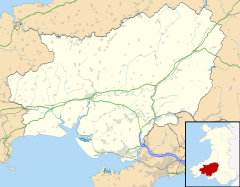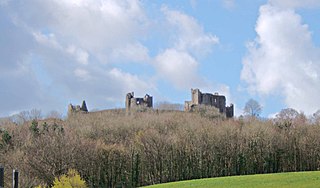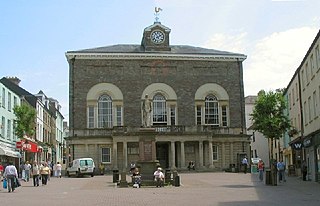
Carmarthenshire is a county in the south-west of Wales. The three largest towns are Llanelli, Carmarthen and Ammanford. Carmarthen is the county town and administrative centre. The county is known as the "Garden of Wales" and is also home to the National Botanic Garden of Wales.

Carmarthen is the county town of Carmarthenshire and a community in Wales, lying on the River Towy 8 miles (13 km) north of its estuary in Carmarthen Bay. The population was 14,185 in 2011, down from 15,854 in 2001, but gauged at 16,285 in 2019. It has a claim to be the oldest town in Wales – Old Carmarthen and New Carmarthen became one borough in 1546. It was the most populous borough in Wales in the 16th–18th centuries, described by William Camden as "chief citie of the country". Growth stagnated by the mid-19th century as new settlements developed in the South Wales Coalfield.
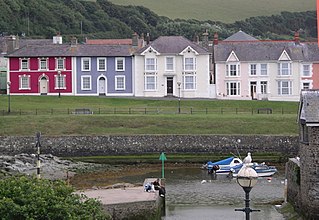
Aberaeron, previously anglicised as Aberayron, is a town, community and electoral ward in Ceredigion, Wales. Located on the coast between Aberystwyth and Cardigan, its resident population was 1,274 in the 2021 census.

Kidwelly is a town and community in Carmarthenshire, southwest Wales, approximately 7 miles (11 km) northwest of the most populous town in the county, Llanelli. In the 2001 census the community of Kidwelly returned a population of 3,289, increasing to 3,523 at the 2011 Census.

Laugharne is a town on the south coast of Carmarthenshire, Wales, lying on the estuary of the River Tâf.

Ferryside is a village in the community of St Ishmael, Carmarthenshire, Wales. It is 8.5 miles (13.7 km) south of Carmarthen near the mouth of the River Tywi. Originally a ferry crossing, then becoming a fishing village, it has developed as a holiday and retirement area. The village has its own lifeboat station and was the first village in the UK to switch from analogue to digital television. The 2011 census showed the village to have 846 residents.

Llansteffan, is a village and community situated on the south coast of Carmarthenshire, Wales, lying on the estuary of the River Tywi, 7 miles (11 km) south of Carmarthen.
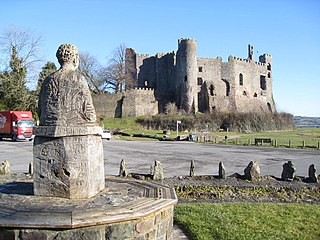
Laugharne Castle is in Laugharne, Carmarthenshire, Wales. The castle, located on the estuary of the River Tâf, was originally established in 1116. It was rebuilt as a Norman stronghold. There have been many alterations since then, including becoming a Tudor fortified manor house in the sixteenth century. It changed hands twice during the English Civil War, being eventually captured by Parliamentary forces in 1644.

Dryslwyn Castle is a native Welsh castle, sited on a rocky hill roughly halfway between Llandeilo and Carmarthen in Wales. It stands on high ground overlooking the Tywi Valley with extensive views. It was built in about the 1220s by one of the princes of the kingdom of Deheubarth, and changed hands several times in the struggles between the Welsh and English over the ensuing centuries. It is considered one of the most important remaining structures built by a Welsh chieftain and is a Grade I listed building.

Carmarthen West and South Pembrokeshire is a constituency of the Senedd. It elects one Member of the Senedd by the first past the post method of election. In addition, it is one of eight constituencies in the Mid and West Wales electoral region, which elects four additional members, in addition to eight constituency members, to produce a degree of proportional representation for the region as a whole.

Llangunnor is a village and community located in Carmarthenshire, Wales. It is the southern suburb of Carmarthen town and consists mainly of typical suburban housing which has expanded in recent years. It has a small shop, two chapels, a church and a Primary School. It is made up of the villages and hamlets of Nantycaws, Pensarn, Login and Pibwrlwyd.

Llangynog is a village and community located in Carmarthenshire, Wales, the main settlement of which was once called ‘Ebenezer’village. It is bordered by the communities of: Newchurch and Merthyr; Carmarthen; Llangain; Llansteffan; Laugharne Township; and St Clears, all being in Carmarthenshire. The population at the 2011 census was 492.

Plas Llanstephan is a mansion in the county of Carmarthenshire, Wales. It is set well back from the public road among pasture fields and is reached by a private driveway from the village of Llansteffan. Both the hall and the stable block are grade II listed buildings. Llansteffan Castle overlooks the house from the summit of a low hill to the southeast.

Castell Moel is the remains of a 16th-century fortified manor house in the community of Llangain in Carmarthenshire, Wales, and also a medieval motte about 600 yards (550 m) to the south of the manor house. The remains are approximately 2.5 miles (4.0 km) south-west Carmarthen and 0.8 miles (1.3 km) north-east of the village of Llangain. Three miles to the north-west is Carmarthen Castle, and five miles to the south-west is Llansteffan Castle.

Llanybri is a rural farming village situated between the estuaries of the River Tywi and River Taf in Carmarthenshire, Wales. It is one of two villages with their own churches in the community of Llansteffan.
Carmarthen Rural District Council was a local authority in the central part of Carmarthenshire, Wales created in 1894. The first election to the authority was held in December 1894.
The first election to the Carmarthen Rural District Council in Carmarthenshire, Wales was held in December 1894. It was followed by the 1898 election. The successful candidates were also elected to the Carmarthen Board of Guardians. In rural parishes, many councillors were returned unopposed.

